Refine search
No keyword found to refine search
keywords EN
Places
Names
224 documents found
| 1 | 4 |
Documents per page :
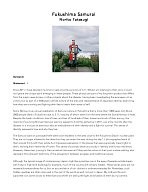
The Samurai of Fukushima / Portraits
Noriko Takasugi / Le Pictorium
LePictorium_0201745.pdf
The Samurais of Fukushima by Noriko Takasugi
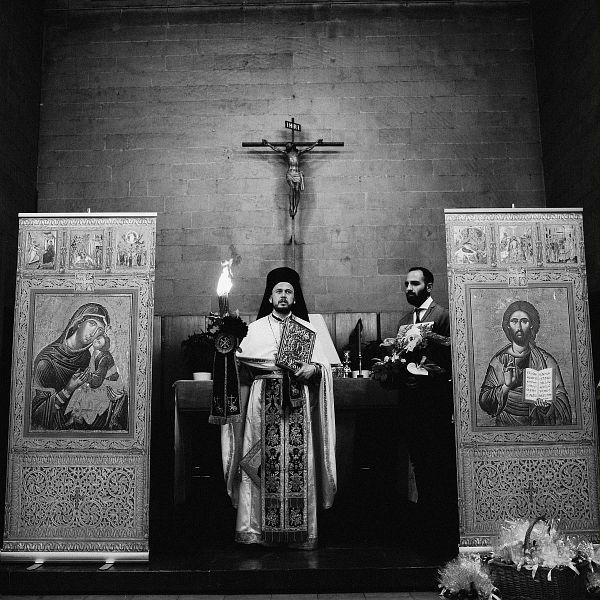
The midnight service of Anastasi.
Pierre Berthuel / Le Pictorium
LePictorium_0177954.jpg
The midnight service of "Anastasi". The greek celebration of easter by the greek community in Barcelona.

Nepal - Katmandou Valley. Visit of the businesses followed by the WOFOWON organisation.
Noémie Repetto / Le Pictorium
LePictorium_0173280.jpg
Small businesses owned exclusively by women. The WOFOWON (Women Forum for Women in Nepal) is an NGO helping those people.

Jean d'Ormesson portrait
Gérard Cambon / Le Pictorium
LePictorium_0172224.jpg
Portrait of Jean d'Ormesson at home. Jean d'Ormesson died of a heart attack on the night of December 4 to 5, 2017.

Jean d'Ormesson portrait
Gérard Cambon / Le Pictorium
LePictorium_0172225.jpg
Portrait of Jean d'Ormesson at home. Jean d'Ormesson died of a heart attack on the night of December 4 to 5, 2017.

Jean d'Ormesson portrait
Gérard Cambon / Le Pictorium
LePictorium_0172226.jpg
Portrait of Jean d'Ormesson at home. Jean d'Ormesson died of a heart attack on the night of December 4 to 5, 2017.
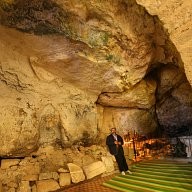
Cave of the Seven Sleepers in Afsin
Manoël Pénicaud / Le Pictorium
LePictorium_0169819.jpg
Known in Islam as the People of the Cave
(Ahl al-Kahf in Arabic), the Seven Sleepers are said to have miraculously slept for several centuries in a cave in order to escape from the persecutions of the Roman Empire. Their awakening is a metaphor for the resurrection
of the body, in both Christianity and in Islam
(Qur’anic sura ‘The Cave’). The narratives
of the Seven Sleepers were widely disseminated. Numerous caves in the Mediterranean region are considered to be sacred places where this miracle occurred. This legend has sometimes given rise to joint veneration by Christians and Muslims.

The Who in concert at Paris
Philippe Gras / Le Pictorium
LePictorium_0146844.jpg
The Who in conert at the "Fêtes de l'Huma", Paris 1972

The Who in concert at Paris
Philippe Gras / Le Pictorium
LePictorium_0145831.jpg
The Who in Theatre des Champs Elysees at Paris, France

The Who in concert at Paris
Philippe Gras / Le Pictorium
LePictorium_0145839.jpg
The Who in Theatre des Champs Elysees at Paris, France
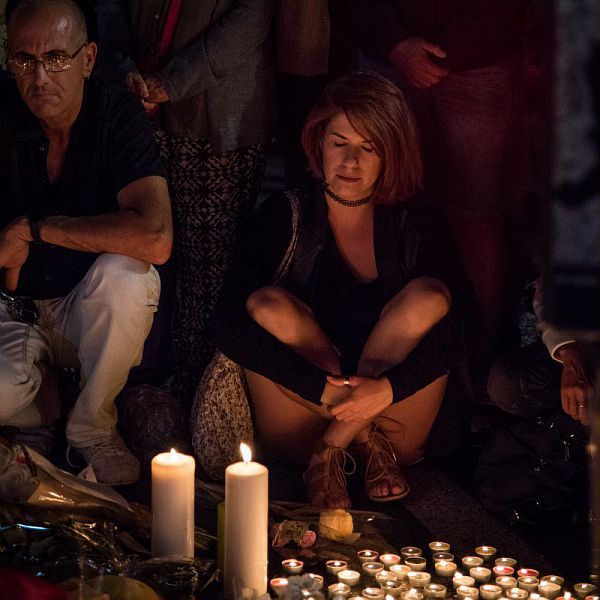
Nice terrorist attack on 14th July 2016
Nicolas Réméné / Le Pictorium
LePictorium_0144659.jpg
Nice on 15 July 2016. At nightfall very many people spontaneously gathered at the Meridian Hotel on the Promenade to honor the victims . People who came alone , with family, or with their children have placed flowers , candles, but also messages. Peace messages It read for relatives who died the night before or just sending a prayer to all deceased. A very strong emotion emanated during this meditation on the Promenade des Anglais in the aftermath of the terrorist attack that killed 84 and wounded more than 200 of which 18 are still in an absolute emergency condition four days after the tragedy. The attack was claimed the next day by the Islamic State
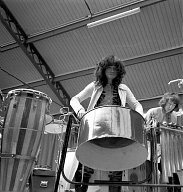
Stomu Yamashta, Japanese composer
Philippe Gras / Le Pictorium
LePictorium_0143592.jpg
Stomu Yamashta, Japanese percussionist and composer

Fukushima 5 years later
Noriko Takasugi / Le Pictorium
LePictorium_0143537.jpg
Hidehiro, who has been running the oldest home electrical appliances shop in Ishinomaki city. After the disaster, he needed to move to the temporary shopping street that was built in December 2011 with 21 shops suffered from the disaster and moved from Ishinomaki city. It was with 2 years deadline but many of them still cannot find the way to be self-supported and extended the deadline to be closed. “I don’t know whether I should go back to my old place to continue this business since it is very difficult to sell the product after we have big shopping mall in the suburbs ”

Fukushima 5 years later
Noriko Takasugi / Le Pictorium
LePictorium_0143540.jpg
Nao and Masami 16 years old, on the way home from high school. Nao’s family has moved to her current house in Ishinomaki city since her house in Kitakami town was totally destroyed by the tsunami that streamed up the Kitakami river. “My father picked me and my brothers by car just after the earthquake. It was so scary that the tsunami came from the front and the side when we are driving up to the hill”. She has been forgotten the experience but she said “This time of the year, I remind of things”.
Masami lives near Hiyoriyama Park.
Masami lives near Hiyoriyama Park.

Fukushima 5 years later
Noriko Takasugi / Le Pictorium
LePictorium_0143544.jpg
Hiroyuki, The executive director of Ishinomaki Hibi Shimbun (Newspaper).
The office was flooded by tsunami as same as any other houses around and rotary press was submerged. They wrote on the newspaper paper roll that was still dry and put as wall newspaper from 12th March, the next day of the disaster, to 17th March and provided essential information about lifeline and the shelter for local people. They haven’t miss publishing newspaper even one day since the disaster.
The office was flooded by tsunami as same as any other houses around and rotary press was submerged. They wrote on the newspaper paper roll that was still dry and put as wall newspaper from 12th March, the next day of the disaster, to 17th March and provided essential information about lifeline and the shelter for local people. They haven’t miss publishing newspaper even one day since the disaster.
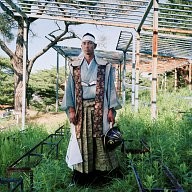
The Fukushima samurais / Portraits
Noriko Takasugi / Le Pictorium
LePictorium_0142648.jpg
Masaki, 30, who used to live in Odaka-ku, decided to stay in the next town “because this is the place where Soma Nomaoi is held”. He took me to the spectator stand in the field where Soma Nomaoi events are held every year. The events were not held here in 2011 because of the high level of radiation exposure. Local people of local company worked hard to decontaminate this area so that events could be held in 2012. Before the disaster, Masaki worked at a manufacturing company located in the town that has been designated as Caution Zone ever since the disaster. He lost his job and decided to get a license to drive large trucks. He was able to find a job at a company that currently mainly does disaster waste processing work or decontamination work (which originally was a engineering and construction company). “We can easily find these type of jobs here now. I needed a job to protect my family and raise my children,” he says.
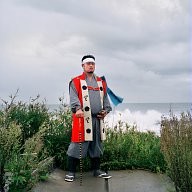
The Fukushima samurais / Portraits
Noriko Takasugi / Le Pictorium
LePictorium_0142649.jpg
Shingo, 34, used to live in Odaka-ku with his wife and children. Their "favorite house" with an ocean view on a hill was washed away 20-meter inland by the tsunami. Downstairs part of the house was completely destroyed. He took me to the side of the house where there used to be a stable and now there is nothing left but the foundation. "We enjoyed watching the ocean from this point," Shingo says, "All the belongings including armor for Soma Nomaoi and two horses that we had taken care of as family were washed away." He let his wife and children move to a neighboring city where the level of radiation exposure is lower while he kept running his own business that removes debris and reconstructs things in Minamisoma city. "I have to stay here and work to raise my family. I'm trying not to think too much about the immediate impact of radiation on our body," says Shingo. His parents living in Tokyo are worried about him.
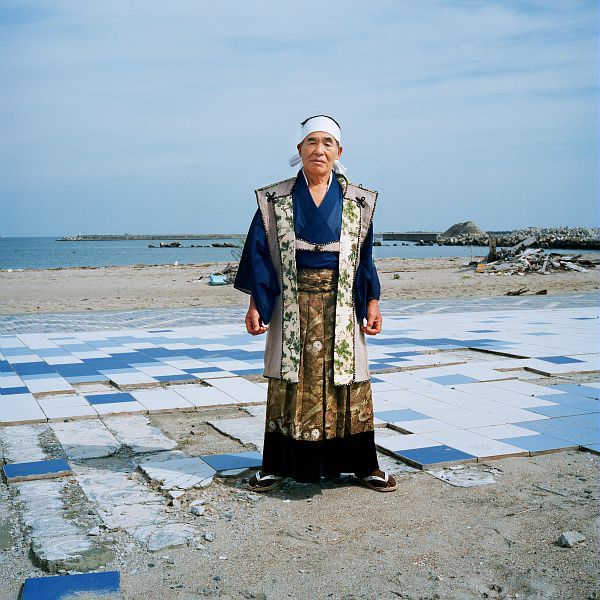
The Fukushima samurais / Portraits
Noriko Takasugi / Le Pictorium
LePictorium_0142650.jpg
"Soma Nomaoi represents life of Japanese Samurai warriors and my way of living. You need that kind of Samurai spirit otherwise you cannot run around wearing that heavy armor in midsummer," says Takakatsu, 68. When it gets closer to Soma Nomaoi, he practices horse racing every morning with his stable mates in this beach where many of his neighbors' bodies were washed up on the beach after the tsunami. Takakatsu's house that was facing the beach was completely destroyed and the some of his horses in his stable next to the house washed away. He piled up dirt on the empty lot to build a new house and lives with his wife here again in the same place. About a dozen of the neighbors who participate in Soma Nomaoi, who need to borrow his horses, help each other living like a family. This place is 45 km from the Fukushima Daiichi nuclear plant, where the level of radiation is lower compared to Minamisoma city.
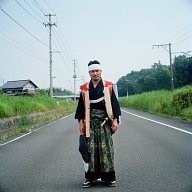
The Fukushima samurais / Portraits
Noriko Takasugi / Le Pictorium
LePictorium_0142651.jpg
Kazuhito, 33, stands in front of his parents' house where he rose up in Odaka-ku. "The tsunami reached just a few hundreds meters away from this place and many people that I knew including Soma Nomaoi friends died," he says. After living at the evacuation center and his wife's cousin's house for several months, he now lives with his wife and children in neighboring prefecture and commutes one hour to the nuclear power plant where he worked before the disaster. He liked horses, especially horse racing, so much that he wanted to become a jockey when he was a teenager. All of his friends acknowledge his superiority in this field. He was happy that Kacchu-keiba (Armed Horse Race), which was canceled in 2011, was held in 2012. He decided not to bring his children to the field where Soma Nomaoi events were held in 2012. "We cannot do anything here if we worry too much about the level of radiation exposure so tend to forget, but we just think it's better for children to stay away from the area. We don't know what the actual impact is though...," he says.
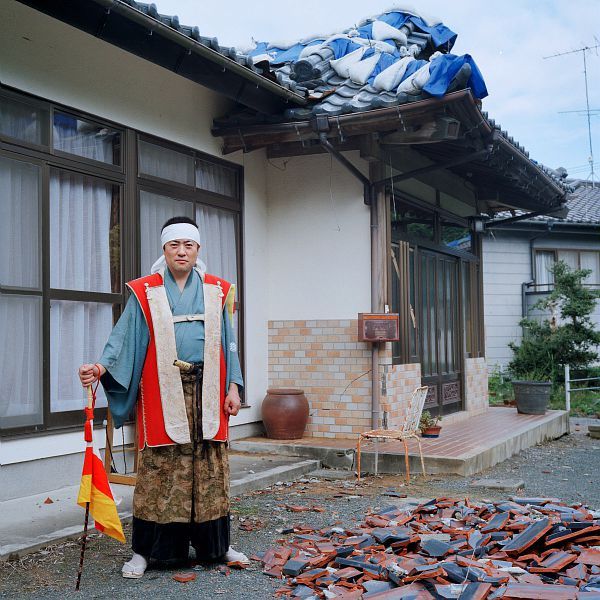
The Fukushima samurais / Portraits
Noriko Takasugi / Le Pictorium
LePictorium_0142652.jpg
Kunihito, 40, stands in front of his parents' house in Odaka-ku where he lived since he was born until the disaster occurred. Roof tiles fell off and walls cracked due to the earthquake, but the house is habitable only if the level of radiation exposure was normal. Currently he lives in a leased housing in the neighboring town with his family and keeps working at the nuclear plant. He grew up watching his grand father being a master of horseback riding. He is happy that Soma Nomaoi is almost back to normal this year in 2012. Kunihito takes pride in the relationship with his Soma Nomaoi he knows since childhood. "I was able to overcome the disaster because of Soma Nomaoi," he says.
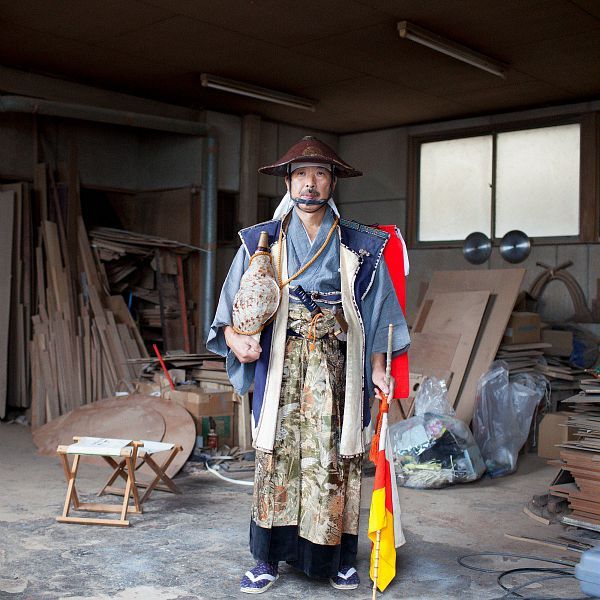
The Fukushima samurais / Portraits
Noriko Takasugi / Le Pictorium
LePictorium_0142653.jpg
Yoshiyuki, 59, took me to his former house that was also his small furniture factory in Odaka-ku where he had lived since he was born and worked locally for more than 35 years. In July 2012, he moved all the equipment from his former home to his new home in another city, where he evacuated to and lives now, to restart the furniture business there. "We might return to Odaka-ku some day but I don't want my children to live here," says Yoshiyuki. "When the disaster occurred, my daughter was in the third trimester of pregnancy. We were trying to determine the best place for her to give birth while moving around for evacuation." He acts as Kaiyaku who blows a conch horn during Soma Nomaoi. "I feel grateful that I have support from my family to participate in Soma Nomaoi, especially last year 2011 and this year 2012 while I was trying to participate during leading evacuation life
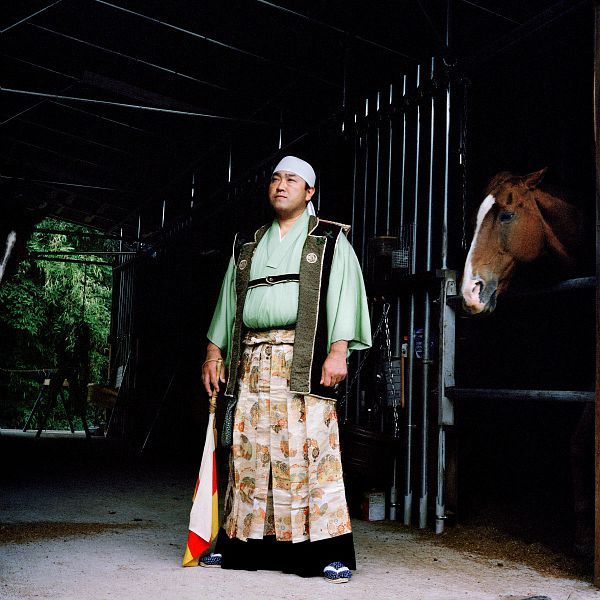
The Fukushima samurais / Portraits
Noriko Takasugi / Le Pictorium
LePictorium_0142654.jpg
Hironobu, 44, took me to a horse stable built by him and his family members after the disaster. Before the disaster, he used to run a youth horse club. Masaki and Kazuhito acquired horse-riding skills at that club to become Nomaoi Samurai warriors. Currently he is taking care of about 10 horses, including the horses that lost their owners and stables due to the disaster that he adopted, in a new stable with his family. He wakes up early to take care of the horses before going to work, and after returning home, cleans the stable and feeds the horses. "It's tough. I can't do it if I don't love horses," he says. Hironobu used to live in Odaka-ku with his family and his parents, who all are Nomaoi Samurai warriors. His children and parents evacuated to his brother's place in a neighboring city where there is little impact of radiation. His wife and he live in leased housing in the neighboring town of Odaka-ku where his works is. "It's been hard for me that I can only see my children during the weekends," says Hironobu.
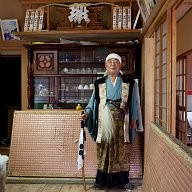
The Fukushima samurais / Portraits
Noriko Takasugi / Le Pictorium
LePictorium_0142655.jpg
I used to stand in front of this kamidana (a household altar) sacred to Odaka Shrine and pray every morning when we were living here before the disaster," says Kunio, 65. Standing solemnly in front of kamidana with gratitude as part of his daily routine was such a precious and calm moment for him. I'm very proud that all of my three sons participated in Soma Nomaoi. I'm deeply touched by the fact that we keep holding Soma Nomaoi trying to overcome the difficulties we faced after the disaster." He still remembers when he received an enthusiastic round of applause from the crowd at Japan Festival held in London back in 1991 when he dressed as samurai with others in front of the Tower of London. He felt connected with the English, many of who love horse riding. "At a dinner reception, I drank the water in the finger bowl by mistake. I thought it was water to drink," he gave big laugh.
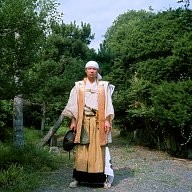
The Fukushima samurais / Portraits
Noriko Takasugi / Le Pictorium
LePictorium_0142656.jpg
Akihito Sato, 38, stands in the garden of his parents' house in Odaka-ku. All of his armor and horse gears for Soma Nomaoi are kept at his parents’ house together with those of his brothers, Kazuhito and Kunihito, and his father Kunio. "My friends and family members are all connected through Soma Nomaoi. Soma Nomaoi often helps to smooth the connection at workplace too," says Akihito. His commitment to Soma Nomaoi comes from his desire to "do it in a cool way" which is to show your ”Rectitude (?)” or Justice, ”Courage (?)” and The spirit of Bearing (?)”, ”Benevolence (?)” and the Feeling of Distress, “Politeness (?)” , “sincerity (?)”, ”Honour (?)” , and ”The Duty of Loyalty (?)”, which from Bushido spirits, subtly to others. Akihito takes pride in the relationship with his Soma Nomaoi mates that he grew up together from very young age. "I was able to overcome the disaster because of Soma Nomaoi," says Sato.
He started his own construction business long time before the disaster. Currently he is busy with nuclear plant related jobs such as scaffolding for decontamination work. He now lives by himself in a leased housing in Minamisoma city because of the work situation having his wife and two children evacuated to another city in Fukushima.
He started his own construction business long time before the disaster. Currently he is busy with nuclear plant related jobs such as scaffolding for decontamination work. He now lives by himself in a leased housing in Minamisoma city because of the work situation having his wife and two children evacuated to another city in Fukushima.

The Fukushima samurais / Portraits
Noriko Takasugi / Le Pictorium
LePictorium_0142657.jpg
"Ever since I was born, Odaka shrine was always there for me at important stages of my life," says Yoshimitsu, 48. He chooses Odaka shrine without hesitation as an important and emotional place in Odaka-ku for him. "I came here to celebrate Seven-Five-Three Festival (a festival to celebrate children's growth and to pray for their future good health) and enrollment ceremonies, or to pray for success with my examinations. I even came here on my first date. And of course, Soma Nomaoi starts from Odaka Shrine every year," he says. He used to live in a house in Odaka-ku close to the Shrine, but now lives in a leased apartment in the neighboring next town with his family. In the past nine years, he has been serving as an executive director for a committee of Soma Nomaoi. "Soma Nomaoi is something that builds ties among people and that makes me grow. It is something that I am proud of being involved in from the bottom of my heart".

The Fukushima samurais
Noriko Takasugi / Le Pictorium
LePictorium_0142698.jpg
The first day of Soma Nomaoi before the march.
samurai 030
samurai 030
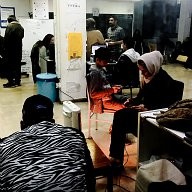
Notara 26: Squatt for migrants in Athens
Stefania Mizara / Le Pictorium
LePictorium_0141376.jpg
The ground floor of Notara 26 building is used like a meeting room for refugees and people of the solidarity movement.
Food serving of food in the dinner room from collective kitchen Nosotros in Notara 26 squat.
Notara 26 is a housing-transit squat for refugees families mainly, passing in Athens, on their way to the Macedonian border.
It is an initiative based on citizen solidarity that has already sheltered more than a thousand refugees since in opened in September 2015.
There is a medical room, a storage department for food and clothes, laundry and 15 rooms for refugees to stay. Food is provided by different collective kitchens of Exarhia.
Food serving of food in the dinner room from collective kitchen Nosotros in Notara 26 squat.
Notara 26 is a housing-transit squat for refugees families mainly, passing in Athens, on their way to the Macedonian border.
It is an initiative based on citizen solidarity that has already sheltered more than a thousand refugees since in opened in September 2015.
There is a medical room, a storage department for food and clothes, laundry and 15 rooms for refugees to stay. Food is provided by different collective kitchens of Exarhia.
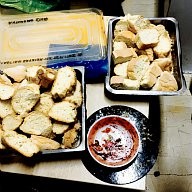
Notara 26: Squatt for migrants in Athens
Stefania Mizara / Le Pictorium
LePictorium_0141377.jpg
Food serving of food in the dinner room from collective kitchen Nosotros in Notara 26 squat.
Notara 26 is a housing-transit squat for refugees families mainly, passing in Athens, on their way to the Macedonian border.
It is an initiative based on citizen solidarity that has already sheltered more than a thousand refugees since in opened in September 2015.
There is a medical room, a storage department for food and clothes, laundry and 15 rooms for refugees to stay. Food is provided by different collective kitchens of Exarhia.
Notara 26 is a housing-transit squat for refugees families mainly, passing in Athens, on their way to the Macedonian border.
It is an initiative based on citizen solidarity that has already sheltered more than a thousand refugees since in opened in September 2015.
There is a medical room, a storage department for food and clothes, laundry and 15 rooms for refugees to stay. Food is provided by different collective kitchens of Exarhia.
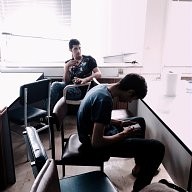
Notara 26: Squatt for migrants in Athens
Stefania Mizara / Le Pictorium
LePictorium_0141383.jpg
Young refugees sit in Notara 26 dining room.
Notara 26 is a housing-transit squat for refugees families mainly, passing in Athens, on their way to the Macedonian border.
It is an initiative based on citizen solidarity that has already sheltered more than a thousand refugees since in opened in September 2015.
There is a medical room, a storage department for food and clothes, laundry and 15 rooms for refugees to stay. Food is provided by different collective kitchens of Exarhia.
Notara 26 is a housing-transit squat for refugees families mainly, passing in Athens, on their way to the Macedonian border.
It is an initiative based on citizen solidarity that has already sheltered more than a thousand refugees since in opened in September 2015.
There is a medical room, a storage department for food and clothes, laundry and 15 rooms for refugees to stay. Food is provided by different collective kitchens of Exarhia.

Notara 26: Squatt for migrants in Athens
Stefania Mizara / Le Pictorium
LePictorium_0141384.jpg
Afgani refugee has a snack in Notara 26 dinning room.
Notara 26 is a housing-transit squat for refugees families mainly, passing in Athens, on their way to the Macedonian border.
It is an initiative based on citizen solidarity that has already sheltered more than a thousand refugees since in opened in September 2015.
There is a medical room, a storage department for food and clothes, laundry and 15 rooms for refugees to stay. Food is provided by different collective kitchens of Exarhia.
Notara 26 is a housing-transit squat for refugees families mainly, passing in Athens, on their way to the Macedonian border.
It is an initiative based on citizen solidarity that has already sheltered more than a thousand refugees since in opened in September 2015.
There is a medical room, a storage department for food and clothes, laundry and 15 rooms for refugees to stay. Food is provided by different collective kitchens of Exarhia.

Notara 26: Squatt for migrants in Athens
Stefania Mizara / Le Pictorium
LePictorium_0141396.jpg
Young refugees eat in the dining room in Notara 26. The dinner was cooked from the collective kitchen Nosotros.
Notara 26 is a housing-transit squat for refugees families mainly, passing in Athens, on their way to the Macedonian border.
It is an initiative based on citizen solidarity that has already sheltered more than a thousand refugees since in opened in September 2015.
There is a medical room, a storage department for food and clothes, laundry and 15 rooms for refugees to stay. Food is provided by different collective kitchens of Exarhia.
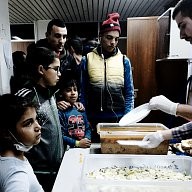
Notara 26: Squatt for migrants in Athens
Stefania Mizara / Le Pictorium
LePictorium_0141397.jpg
Food serving of food in the dinner room from collective kitchen Nosotros in Notara 26 squat.
Notara 26 is a housing-transit squat for refugees families mainly, passing in Athens, on their way to the Macedonian border.
It is an initiative based on citizen solidarity that has already sheltered more than a thousand refugees since in opened in September 2015.
There is a medical room, a storage department for food and clothes, laundry and 15 rooms for refugees to stay. Food is provided by different collective kitchens of Exarhia.

Notara 26: Squatt for migrants in Athens
Stefania Mizara / Le Pictorium
LePictorium_0141398.jpg
Food serving of food in the dining room in Notara 26, cooked from the collective kitchen Nosotros.
Notara 26 is a housing-transit squat for refugees families mainly, passing in Athens, on their way to the Macedonian border.
It is an initiative based on citizen solidarity that has already sheltered more than a thousand refugees since in opened in September 2015.
There is a medical room, a storage department for food and clothes, laundry and 15 rooms for refugees to stay. Food is provided by different collective kitchens of Exarhia.
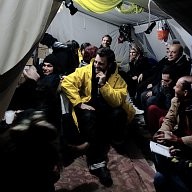
Platanos: Land occupation in North Lesbos for the migrants
Stefania Mizara / Le Pictorium
LePictorium_0141318.jpg
Solidarity people of Platanos gather in a tent for the daily assembly, where decisions are taken. Platanos is a citizen initative, an occupation of land in the outskirts of Scala Sycamnias, a small village in the northern coast of Lesvos, where 5 big tents have been settled to stock warm clothes and an isobox stocking food. Now the camping car comes to cover the need of a medical space.
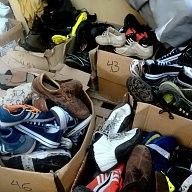
Platanos: Land occupation in North Lesbos for the migrants
Stefania Mizara / Le Pictorium
LePictorium_0141319.jpg
Shoes sent from people from all over Greece, in Platanos cloth storage. Platanos is a citizen initative, an occupation of land in the outskirts of Scala Sycamnias, a small village in the northern coast of Lesvos, where 5 big tents have been settled to stock warm clothes and an isobox stocking food. Since January a campign car, transformed in a medical room covers the medical emergencies
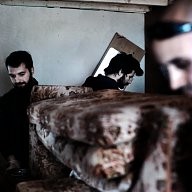
Platanos: Land occupation in North Lesbos for the migrants
Stefania Mizara / Le Pictorium
LePictorium_0141321.jpg
Platanos team transform the camping car to a medical room. Platanos is a citizen initative, an occupation of land in the outskirts of Scala Sycamnias, a small village in the northern coast of Lesvos, where 5 big tents have been settled to stock warm clothes and an isobox stocking food. Since January a campign car, transformed in a medical room covers the medical emergencies
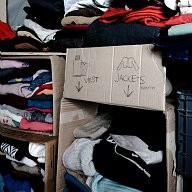
Platanos: Land occupation in North Lesbos for the migrants
Stefania Mizara / Le Pictorium
LePictorium_0141323.jpg
Shelves of clothes in the women's tent. Platanos is a citizen initative, an occupation of land in the outskirts of Scala Sycamnias, a small village in the northern coast of Lesvos, where 5 big tents have been settled to stock warm clothes and an isobox stocking food. Since January a campign car, transformed in a medical room covers the medical emergencies
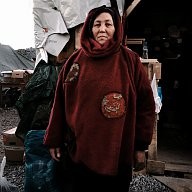
Platanos: Land occupation in North Lesbos for the migrants
Stefania Mizara / Le Pictorium
LePictorium_0141324.jpg
An Afgani woman stands in front of the women's tent. Teresa came to Lesvos worked for two weeks in Platanos camp. Platanos is a citizen initative, an occupation of land in the outskirts of Scala Sycamnias, a small village in the northern coast of Lesvos, where 5 big tents have been settled to stock warm clothes and an isobox stocking food. Since January a campign car, transformed in a medical room covers the medical emergencies

Platanos: Land occupation in North Lesbos for the migrants
Stefania Mizara / Le Pictorium
LePictorium_0141325.jpg
Women change in a tent at the back space of Platanos camp. Platanos is a citizen initative, an occupation of land in the outskirts of Scala Sycamnias, a small village in the northern coast of Lesvos, where 5 big tents have been settled to stock warm clothes and an isobox stocking food. Since January a campign car, transformed in a medical room covers the medical emergencies.
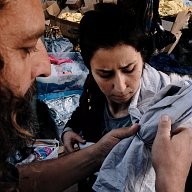
Platanos: Land occupation in North Lesbos for the migrants
Stefania Mizara / Le Pictorium
LePictorium_0141326.jpg
Vasilis from Platanos camp shows to an Syrian woman how to tie the baby carrier made by a solidarity initiative in Athens. Platanos is a citizen initative, an occupation of land in the outskirts of Scala Sycamnias, a small village in the northern coast of Lesvos, where 5 big tents have been settled to stock warm clothes and an isobox stocking food. Since January a campign car, transformed in a medical room covers the medical emergencies
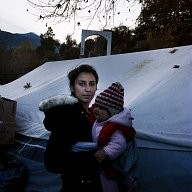
Platanos: Land occupation in North Lesbos for the migrants
Stefania Mizara / Le Pictorium
LePictorium_0141327.jpg
A Syrian woman stands in front of Platanos Tent, with a the baby carrier made by a solidarity initiative for baby carriers in Athens. Platanos is a citizen initative, an occupation of land in the outskirts of Scala Sycamnias, a small village in the northern coast of Lesvos, where 5 big tents have been settled to stock warm clothes and an isobox stocking food. Since January a campign car, transformed in a medical room covers the medical emergencies
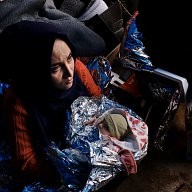
Platanos: Land occupation in North Lesbos for the migrants
Stefania Mizara / Le Pictorium
LePictorium_0141329.jpg
A young refugee with her baby sit on the porch of the medical room of Platanos. Platanos is a citizen initative, an occupation of land in the outskirts of Scala Sycamnias, a small village in the northern coast of Lesvos, where 5 big tents have been settled to stock warm clothes and an isobox stocking food. Since January a campign car, transformed in a medical room covers the medical emergencies
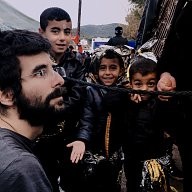
Platanos: Land occupation in North Lesbos for the migrants
Stefania Mizara / Le Pictorium
LePictorium_0141331.jpg
Fotis (left) keeps an eye on the children wile their parents change to dry clothes after crossing the 7,5 miles of water between Turkey and Lesvos, in floating boats. Platanos is a citizen initative, an occupation of land in the outskirts of Scala Sycamnias, where 5 big tents have been settled to stock warm clothes and an isobox, stocking food for the refugees arriving from the coast of Turkey to Scala Sycamnias, in the northern part of Lesvos.
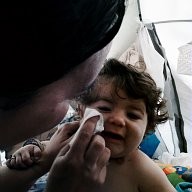
Platanos: Land occupation in North Lesbos for the migrants
Stefania Mizara / Le Pictorium
LePictorium_0141332.jpg
A baby girl cries as one of the members of Platanos camp is trying to change her to dry clothes just after having crossed the sea between Turkish coast andd Lesvos island with her mother. Platanos is a citizen initative, an occupation of land in the outskirts of Scala Sycamnias, a small village in the northern coast of Lesvos, where 5 big tents have been settled to stock warm clothes and an isobox stocking food.
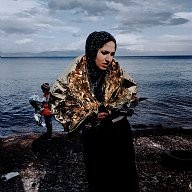
Platanos: Land occupation in North Lesbos for the migrants
Stefania Mizara / Le Pictorium
LePictorium_0141333.jpg
Refugees wrap themselves on isothermic blankets on the beach of Kagia, near Scala Sycamnias. Platanos is a citizen initative, an occupation of land in the outskirts of Scala Sycamnias, a small village in the northern coast of Lesvos, where 5 big tents have been settled to stock warm clothes and an isobox stocking food.

Platanos: Land occupation in North Lesbos for the migrants
Stefania Mizara / Le Pictorium
LePictorium_0141356.jpg
Despoina, a 20 year old student organises the childen's clothes department in Platanos. Platanos is a citizen initative, an occupation of land in the outskirts of Scala Sycamnias, where 5 big tents have been settled to stock warm clothes and an isobox, stocking food for the refugees arriving from the coast of turkey to Scala Sycamnias, in the northern part of Lesvos.
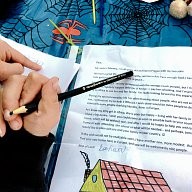
Platanos: Land occupation in North Lesbos for the migrants
Stefania Mizara / Le Pictorium
LePictorium_0141357.jpg
Young boy from Syria copies a letter sent from a woman in Prague with drawings from her children to the children of the refugees as a sign of solidarity, in the playground of Platanos camp. Platanos is a citizen initative, an occupation of land in the outskirts of Scala Sycamnias, a small village in the northern coast of Lesvos, where 5 big tents have been settled to stock warm clothes and an isobox stocking food.
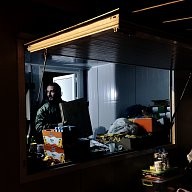
Platanos: Land occupation in North Lesbos for the migrants
Stefania Mizara / Le Pictorium
LePictorium_0141358.jpg
A man arranges the food storage in Platanos Camp, a citizen initative, an occupation of land in the outskirts of Scala Sycamnias, a small village in the northern coast of Lesvos, where 5 big tents have been settled to stock warm clothes and an isobox stocking food. Since January a campign car, transformed in a medical room covers the medical emergencies
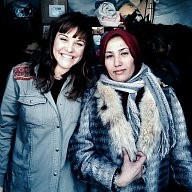
Platanos: Land occupation in North Lesbos for the migrants
Stefania Mizara / Le Pictorium
LePictorium_0141359.jpg
Teresa from Spain (left) and a Syrian woman (right) dressed by her, stand in front of the women's tent. Teresa came to Lesvos worked for two weeks in Platanos camp. Platanos is a citizen initative, an occupation of land in the outskirts of Scala Sycamnias, a small village in the northern coast of Lesvos, where 5 big tents have been settled to stock warm clothes and an isobox stocking food. Since January a campign car, transformed in a medical room covers the medical emergencies.
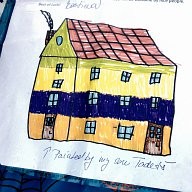
Platanos: Land occupation in North Lesbos for the migrants
Stefania Mizara / Le Pictorium
LePictorium_0141360.jpg
A letter sent from a woman in Prague with drawings from her children to the children of the refugees as a sign of solidarity in the playground of Platanos camp. Platanos is a citizen initative, an occupation of land in the outskirts of Scala Sycamnias, a small village in the northern coast of Lesvos, where 5 big tents have been settled to stock warm clothes and an isobox stocking food.
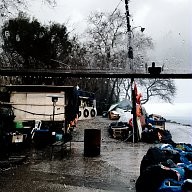
Platanos: Land occupation in North Lesbos for the migrants
Stefania Mizara / Le Pictorium
LePictorium_0141362.jpg
Platanos is a citizen initative, an occupation of land in the outskirts of Scala Sycamnias, where 5 big tents have been settled to stock warm clothes and an isobox, stocking food for the refugees arriving from the coast of turkey to Scala Sycamnias, in the northern part of Lesvos.
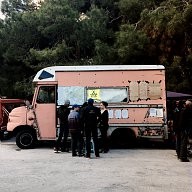
Migrants assistance on Lesvos Island
Stefania Mizara / Le Pictorium
LePictorium_0141288.jpg
Refugees note down links and information for the trip through the Balcans from the no border kitchen van. The no border kitchen is a citizen initiative from Germany that provided food to refugees in different places: Idomeni, Athens and here Lesvos.
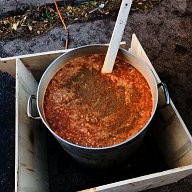
Migrants assistance on Lesvos Island
Stefania Mizara / Le Pictorium
LePictorium_0141289.jpg
Hot soup cooking in the No Border kitchen. The no border kitchen is a citizen initiative from Germany that provided food to refugees in different places: Idomeni, Athens and here Lesvos.
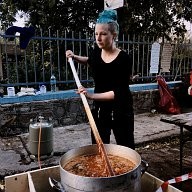
Migrants assistance on Lesvos Island
Stefania Mizara / Le Pictorium
LePictorium_0141290.jpg
Woman from Germany came to cook to the refugees in the No Border Kitchen. The no border kitchen is a citizen initiative from Germany that provided food to refugees in different places: Idomeni, Athens and here Lesvos.

Platanos: Land occupation in North Lesbos for the migrants
Stefania Mizara / Le Pictorium
LePictorium_0141328.jpg
Baby girl is taken care of while her mother is changing to dry clothes in Platanoa camps, after having crossed the sea between the turkish coast and Lesvos. Platanos is a citizen initative, an occupation of land in the outskirts of Scala Sycamnias, a small village in the northern coast of Lesvos, where 5 big tents have been settled to stock warm clothes and an isobox stocking food. Since January a campign car, transformed in a medical room covers the medical emergencies
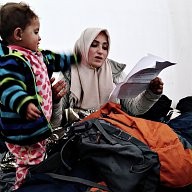
Migrants on Chios Island
Stefania Mizara / Le Pictorium
LePictorium_0140721.jpg
Syrian woman reads the letter that was in the backpack offered from dancers of the Winter-rise festival . The backpacks contained steeling bag, thermos and food. A team of five arrived in Chios island and in collaboration with the locals (Chios Solidarity) who are organising and supporting the refugee passage gave the emergency backpacks the first week of January 2016.
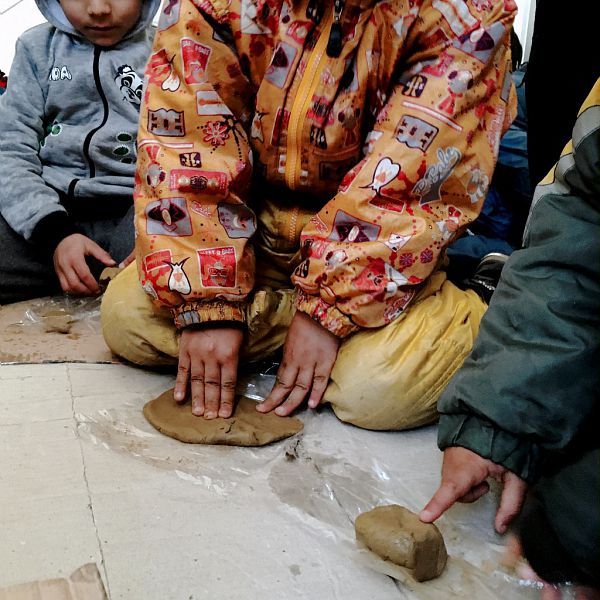
Migrants on Chios Island
Stefania Mizara / Le Pictorium
LePictorium_0140715.jpg
Refugees, adults and children participate at a clay workshop in the UNHCR tent, while waiting for their papers to be processed. The workshop was organised from dancers and actors from Winter-rise festival gathered money to buy backpacks to distribute to the families of immigrants. The backpacks contained steeling bag, thermos and food. A team of five arrived in Chios island and in collaboration with the locals (Chios Solidarity) who are organising and supporting the refugee passage gave the emergency backpacks the first week of January 2016.
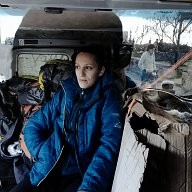
Migrants on Chios Island
Stefania Mizara / Le Pictorium
LePictorium_0140718.jpg
Despoina is sitting on the back of the van with the backpacks in Chios port. Dancers and actors from Winter-rise festival gathered money to buy backpacks to distribute to the families of immigrants. The backpacks contained steeling bag, thermos and food. A team of five arrived in Chios island and in collaboration with the locals (Chios Solidarity) who are organising and supporting the refugee passage gave the emergency backpacks the first week of January 2016.
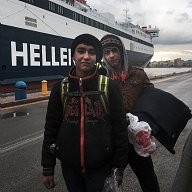
Migrants on Chios Island
Stefania Mizara / Le Pictorium
LePictorium_0140719.jpg
Young refugees in front of the ship, that will take them to Athens wear the backpacks ofered to them from dancers from Winter-rise festival, who gathered money to buy backpacks. The backpacks contained steeling bag, thermos and food. A team of five arrived in Chios island and in collaboration with the locals (Chios Solidarity) who are organising and supporting the refugee passage gave the emergency backpacks the first week of January 2016.
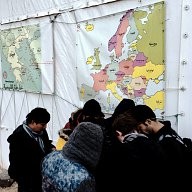
Migrants on Chios Island
Stefania Mizara / Le Pictorium
LePictorium_0140720.jpg
Refugees gathered in front of the UNHCR tent in Chios port.
Next page
